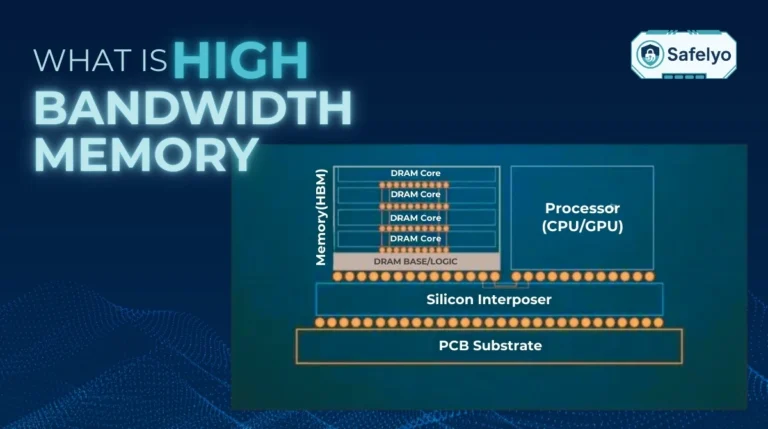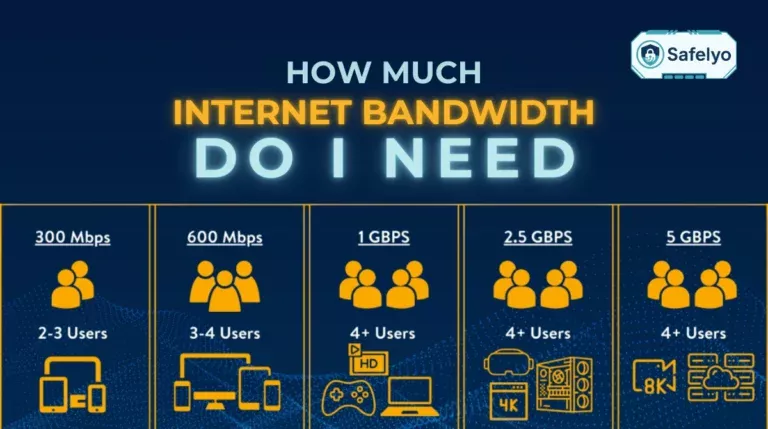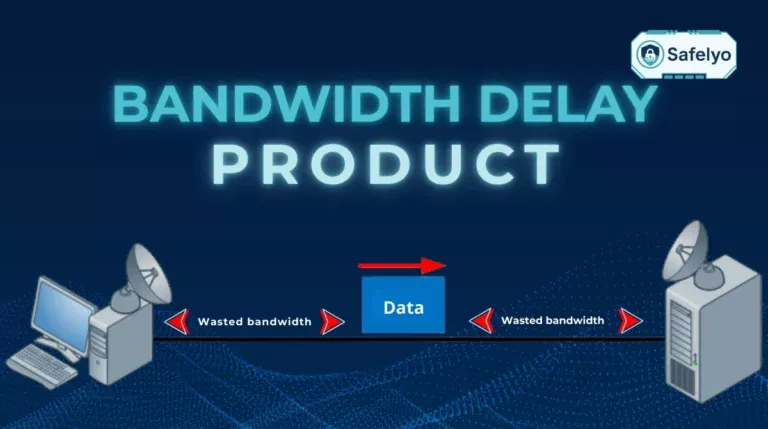You’ve heard about the immense power of Google Cloud, but the platform can seem intimidating, especially with its complex pricing and technical jargon. If you’re looking for a Google Cloud VPS server, you’re in the right place – but you need to know that Google calls it something different: A ‘Compute Engine VM instance’.
It’s a platform that offers limitless power, but is it the right choice compared to simpler providers? And more importantly, how can you tap into that power without getting a surprise bill at the end of the month?
As a cloud consultant who has guided many developers and small businesses through this exact decision, I know how daunting the Google Cloud console can feel. My goal is to demystify it, showing you that with the right guidance, its power is accessible to everyone, not just enterprise experts.
In this comprehensive guide, you’ll discover:
- What Google Cloud’s VPS is, explained with a simple ‘Lego’ analogy.
- The key differences between Google Cloud and simpler VPS providers.
- How to get and set up a Google VPS for free, forever, using the ‘Always Free Tier’.
- A practical guide to hosting a WordPress site on your new server.
Don’t let the complexity of a professional cloud platform hold you back. Let me be your guide to launching your first server, without the risk or the cost.
1. Google Cloud VPS server vs. traditional VPS
The best way to understand the fundamental difference between a Google Cloud VPS server and other providers is to think about Lego. As someone who has built projects on both, I find this analogy perfectly captures the core philosophy of each approach.
Here’s a quick summary of the two approaches:
| Feature | Traditional VPS (Lego Duplo) | Google Cloud VPS (Lego Technic) |
| Simplicity | ⭐⭐⭐⭐⭐ Very High. Point, click, and deploy. | ⭐⭐ Low. Steep learning curve with many options. |
| Pricing Model | ⭐⭐⭐⭐⭐ Simple. Fixed, predictable monthly cost. | ⭐⭐ Complex. Pay-as-you-go for dozens of components. |
| Flexibility | ⭐⭐⭐ Good. Pre-defined plans and options. | ⭐⭐⭐⭐⭐ Infinite. Total control over every resource. |
| Ecosystem | ⭐⭐ Focused. Mainly compute, storage, and networking. | ⭐⭐⭐⭐⭐ Massive. Integrates with AI, Big Data, and more. |
| Best For… | Beginners, simple websites, predictable budgets. | Scalable applications, developers, and businesses. |
1.1. Traditional VPS Providers
Providers like DigitalOcean offer large, simple, easy-to-handle blocks.
- You get a pre-defined set of resources – a specific amount of CPU, RAM, and storage – for a simple, fixed monthly price (e.g., $6/month).
- It’s incredibly easy to build a strong, functional structure, like a website or a simple application, very quickly. You know exactly what you’re getting and exactly what it will cost.
- This is perfect for beginners, developers who love simplicity, and projects that need predictable costs.
1.2. Google Cloud VPS
The Google Cloud Compute Engine provides you with a vast, almost infinite collection of tiny, specialized, and incredibly powerful pieces.
- You don’t buy a pre-made kit; you select every single component: the exact type of CPU, the amount of RAM, the specific kind of persistent disks for storage, the network configuration, and dozens of other advanced options.
- You can build anything you can imagine, from a simple car to a complex robotic arm with integrated AI and load balancing. The possibilities are limitless, but it requires more skill and planning.
- The Google Cloud VPS pricing reflects this. It’s a “pay-as-you-go” model where the final cost depends on exactly how many pieces you use and for how long.
The bottom line of the Google Cloud vs DigitalOcean debate is a question of philosophy. Do you want the simplicity and predictable cost of Duplo, or the infinite power and scalability of Technic?
>> For many, the best way to start is by trying out the “Technic” set for free.
2. A guided tour of the Google Cloud is always free tier
The biggest hesitation I hear from developers and small business owners about trying Google Cloud is the fear of a surprise bill. The Google Cloud VPS pricing model is powerful but complex, and it’s easy to accidentally rack up charges if you don’t know what you’re doing.
That’s why the best way to start your journey is with the incredibly generous Google Cloud Always Free Tier. This isn’t a temporary 30-day trial. It’s a specific set of resources you can use for free, forever, as long as you stay within the monthly limits.
Think of it as Google giving you a small starter kit of “Lego Technic” pieces every single month, so you can learn and build without any financial risk. For anyone looking for a free Google VPS option, this is the official and best way to get it.
What you get for your free VPS:
Here are the key components of the Google Cloud Always Free Tier that apply to your server:
- 1 e2-micro VM instance per month: This is a small, shared-core server. It’s not a powerhouse, but it’s sufficient for learning the platform and running a low-traffic blog. It also works well for testing software or hosting small personal projects like a private Git server.
- 30 GB of standard persistent disk storage: This is your server’s hard drive. 30 GB is plenty of space for your operating system (like Debian or Ubuntu) and the files for a simple website or application.
- 1 GB of network egress per month to North America: This is the amount of data you can send from your server out to the internet for free. 1 GB is enough for a small site with a few thousand visitors per month.
On top of this, you also get free usage of other powerful tools like 5 GB of Cloud Storage, a small Firestore database, and more. This free tier is the perfect sandbox. It’s exactly how I started my own journey with Google Cloud Platform, allowing me to experiment and make mistakes without ever worrying about the cost. In the next section, we’ll walk through exactly how to set up a VPS on Google Cloud using only these free resources.
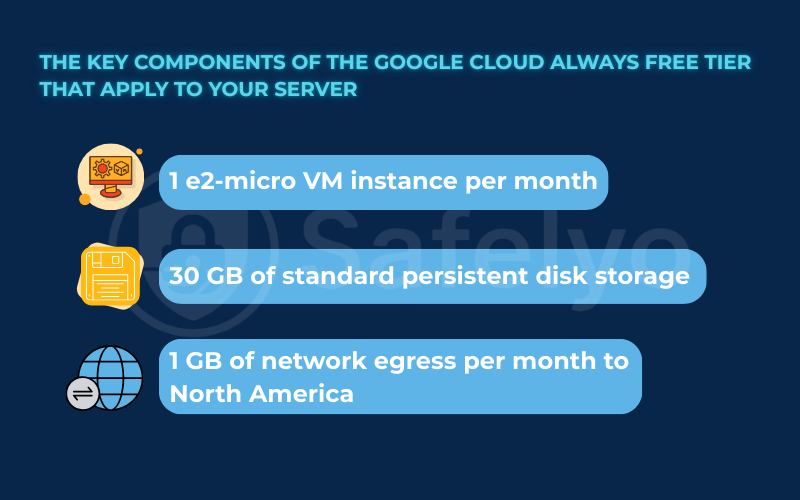
3. How to set up your first free VPS on Google Cloud
Launching your first Google Cloud VM instance can feel daunting. The console is packed with options, and choosing the wrong one can lead to unexpected charges. As someone who has set up hundreds of these, I can tell you that the process is simple once you know exactly which buttons to press.
This Google Cloud VM instance tutorial will guide you through every single step to launch your server using only the Google Cloud Always Free Tier.
Step 1: Create a Google Cloud account
First, you need an account. Go to the Google Cloud Console and sign in with your regular Google account.
- Verification: You will need to provide a credit card for verification purposes. You will not be charged as long as you follow the steps below and stay within the free tier limits. This is a standard identity verification step for all major cloud providers.
- Free Trial Credits: New users also often get a generous free trial with hundreds of dollars in credits to experiment with paid services. We will ignore this for now and focus only on the always-free resources.
Step 2: Navigate to Compute Engine
Once you’re in the Google Cloud Console (it might look a bit overwhelming at first), use the search bar at the top and type “Compute Engine”. Click on the result to go to the Google Cloud Compute Engine dashboard. If it’s your first time, you may need to wait a minute for the API to be enabled. Then, click “Create Instance”.
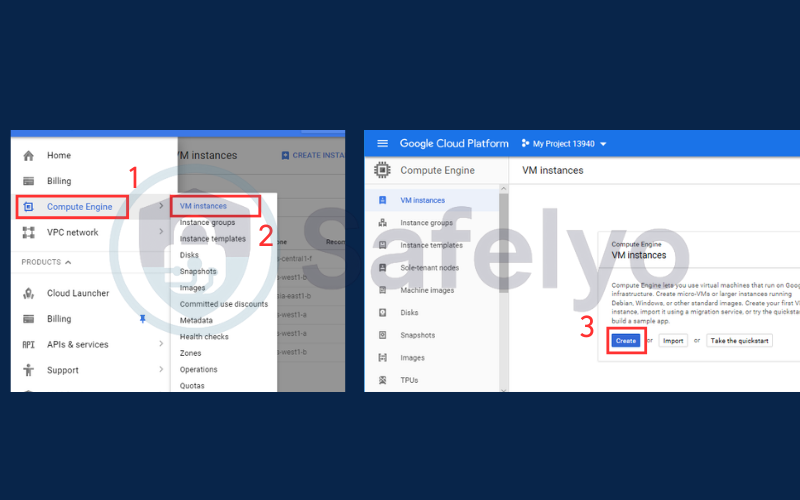
Step 3: Configure your free VM (The Critical Step)
This is the most important part of the process. You must choose the exact settings below to qualify for the Google VPS free tier. Selecting a different option will result in charges.
- Name: Give your instance a name, like my-first-VPS.
- Region: You must choose one of the three US regions:
- us-west1 (Oregon)
- us-central1 (Iowa)
- us-east1 (South Carolina)
- Machine family: Choose General-purpose.
- Series: Choose E2.
- Machine type: Choose e2-micro (2 vCPU, 1 GB memory). This is the specific free instance type.
- Boot disk: This is your operating system. Click “Change”.
- Operating system: Select a free OS like Debian or Ubuntu. The latest stable version is usually fine.
- Version: Choose the default.
- Boot disk type: Choose Standard persistent disk.
- Size (GB): Change the size to 30 GB or less. The default is often smaller, but 30 is the free tier limit.
- Click “Select”.
- Firewall: Check both boxes:
- Allow HTTP traffic
- Allow HTTPS traffic
This opens the standard ports for web traffic, which is essential if you plan to host a website.
Step 4: Create and Connect
Review your settings one last time to ensure they match the free tier requirements. Then, scroll to the bottom and click the “Create” button.
It will take a minute or two for your VPS to be created. Once it’s running, you’ll see it listed on the Compute Engine dashboard. To connect to it, simply click the “SSH” button next to its name. This will open a secure command-line terminal directly in your browser.
Congratulations! You’ve just launched your first Google Cloud VPS server, and it won’t cost you a dime.
4. A popular use case: Installing WordPress on your Google Cloud VPS
Now that your free Google Cloud VPS server is up and running, what can you actually do with it? While it’s a great sandbox for learning Linux, one of the most popular and practical uses is to host a WordPress website.
Running Google Cloud for WordPress gives you a high-performance foundation from one of the world’s fastest networks, all for free (for a low-traffic site). I’ve set up dozens of WordPress sites on these e2-micro instances, and for personal blogs or portfolio sites, they work surprisingly well.
There are two main paths you can take to get WordPress running.
4.1. The easy way (Marketplace)
This is the method I recommend for 99% of beginners. The Google Cloud Marketplace offers pre-configured software packages that handle all the complicated installation steps for you.
- In the Google Cloud Console, search for “Marketplace”.
- In the Marketplace, search for “WordPress”.
- You’ll find several options. Look for one like “WordPress packaged by Bitnami” or “WordPress with NGINX and SSL Certified by Bitnami”. These are well-respected and often free-tier eligible.
- Click “Launch” and follow the on-screen instructions. It will automatically create a new VM instance with WordPress, its database, and all necessary components already installed and secured.
This is the fastest way to get a fully functional WordPress site running in just a few minutes.
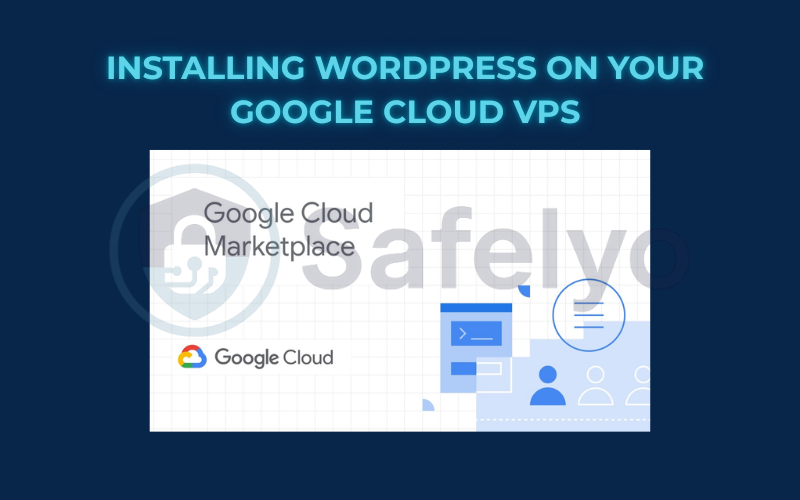
4.2. The DIY way (manual install)
For those who want more control and a fantastic learning experience, you can install everything manually. This involves connecting to your server via SSH (as we did in the last step) and typing in commands to install a “LAMP” stack, which stands for:
- Linux (your Debian or Ubuntu OS)
- Apache (your web server software)
- MySQL (your database)
- PHP (the programming language WordPress runs on)
Once the LAMP stack is in place, you download and configure WordPress itself. While this path is more challenging, it gives you a deep understanding of how a web server works from the ground up.
If you’re interested in this hands-on approach, we have a complete, step-by-step tutorial you can follow. Just check out our dedicated guide on how to install Google Cloud for WordPress manually.
>> You may also be interested in: How to install WordPress on a local server (2 easy methods)
5. Is a Google Cloud VPS good for you?
You’ve now seen how to launch a Google Cloud VPS server for free and even install a popular application like WordPress. But the fundamental question remains: Is Google Cloud VPS good for you and your project?
The answer comes back to our Lego analogy. The choice isn’t about which is “better” in a vacuum, but which is the right tool for the builder. I’ve used both types of platforms for different projects, and each has a clear time and place.
This table compares the core “philosophy” of Google Cloud against the more traditional, VPS-focused providers.
| Criteria | Google Cloud VPS | VPS-Focused Providers |
| Best For… | Scalable applications, developers, and businesses that need flexibility and a vast ecosystem of tools. | Websites, personal projects, and beginners who value simplicity and predictable costs. |
| Simplicity | ⭐⭐ Low. The platform has a steep learning curve with a professional, complex interface. | ⭐⭐⭐⭐⭐ Very High. They are designed from the ground up to be intuitive, with clean, user-friendly dashboards. |
| Pricing Model | ⭐⭐ Complex. The pay-as-you-go cost model is powerful but can be confusing and hard to predict. | ⭐⭐⭐⭐⭐ Simple. You pay a fixed monthly price for a set amount of resources. No surprises. |
| Performance | ⭐⭐⭐⭐⭐ Excellent. You are running on Google’s world-class global network infrastructure. | ⭐⭐⭐⭐ Very Good. These providers use enterprise-grade hardware and offer excellent performance for the price. |
| Ecosystem | ⭐⭐⭐⭐⭐ Massive. Your VPS can seamlessly integrate with Google’s other powerful services like AI/ML, BigQuery, Cloud CDN, and Kubernetes. | ⭐⭐⭐ Focused. They excel at their core compute features (VPS, storage, basic networking) but have a smaller ecosystem. |
Ultimately, my advice is this:
If your primary goal is to launch a website quickly with a predictable budget and minimal fuss, a provider like DigitalOcean or Vultr is often a better starting point.
If you’re a developer seeking access to a vast ecosystem of tools, mastering the “Lego Technic” of Google Cloud Platform is invaluable. This knowledge is a worthwhile investment, especially if you expect your application to scale significantly in the future.
6. FAQ about the Google Cloud VPS server
We’ve explored the Lego analogy and launched a free server, but you might still have some specific questions. Here are direct answers to the most common queries about Google Cloud’s VPS offering.
What is a Google Cloud VPS server?
A Google Cloud VPS server commonly refers to a virtual machine hosted on the Google Cloud Platform. The official name for this service is a Google Cloud Compute Engine Virtual Machine (VM) instance. It offers a private virtual server environment within Google’s global infrastructure.
Does Google Cloud provide VPS?
Yes, it does. While they don’t use the term “VPS” in their marketing, their Compute Engine service is one of the most powerful and scalable VPS solutions in the world.
Is the Google VPS free forever?
Yes, the Google Cloud Always Free Tier provides specific resources, including one e2-micro VM instance, that you can use every month without charge. As long as you stay within the specified usage limits (e.g., a US region, 30 GB storage), you can run a small server for free, indefinitely.
Does Google Cloud provide hosting?
Yes, Google Cloud provides a wide range of hosting solutions. You can use a Compute Engine VM for traditional server hosting. Alternatively, consider App Engine for managed application hosting, Cloud Run for containerized apps, or Cloud Storage for static website hosting.
Is Google Cloud VPS good for beginners?
It can be challenging. While extremely powerful, the platform has a steep learning curve compared to simpler providers like DigitalOcean. It’s designed for professionals and developers. However, following a detailed Google Cloud VM instance tutorial like ours can make the process much easier for a beginner to get started.
What is the GCP equivalent of EC2?
Google Cloud Compute Engine is the direct equivalent of Amazon Web Services’ (AWS) EC2 (Elastic Compute Cloud). Both services allow you to create and manage scalable virtual machines (servers) in the cloud.
Can I get a refund if I’m charged by mistake?
Google Cloud has a very precise, second-by-second billing system. It is crucial to set up billing alerts in the “Billing” section of the console to notify you if you are approaching a certain spending threshold. This is the best way to avoid unexpected charges. Refunds for accidental usage are not guaranteed and are handled on a case-by-case basis by their support team.
7. Conclusion
Selecting between a Google Cloud VPS server and a simpler VPS provider is akin to choosing between a box of Lego Technic and a box of Lego Duplo. Both are valuable tools, but they cater to different builders and project types.
- Google Cloud’s VPS is called Compute Engine, and it’s an incredibly powerful and scalable platform.
- Its complexity and pay-as-you-go pricing model are better suited for developers and businesses than for absolute beginners.
- The Google Cloud Always Free Tier is a fantastic, risk-free way to learn the platform and host small projects.
- For simple websites or predictable costs, a provider like DigitalOcean might be a better starting point.
Don’t be intimidated by the power of Google Cloud. Use the free tier to your advantage, learn the ropes by following a good tutorial, and you’ll have access to a world-class infrastructure that can grow with any idea you have.
Now that you’ve set up your server, the next step is securing it. Explore the guides on server security basics and firewall rules in our Tech How-To Simplified section to protect your new VM instance with Safelyo.


